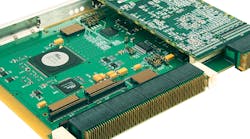VITA and its members play a key role in the critical embedded computing industry. Technology innovation by these members have opened the doors to new applications in several industries. VITA, the organization that provides an environment for the development and evangelization of these technologies has entered a new chapter in its history. There were key changes in personnel at VITA in 2014 that also included many improvements to the tools the members use for collaboration. 2015 promises to continue with more improvements on the roadmap including a re-kindling of VITA’s international appeal; reinforcing VITA’s tradition of creating the best open architectures, open standards remain the sole focus.
2015 trend predictions
Let’s first take a look at a few of the industry trends that are impacting VITA members and follow that up with insight into the challenges facing us in 2015.
Military programs are stabilizing. The industry is not out of the woods yet as uncertainty continues to cloud the direction many programs might take. What is known is that new defense programs will depend more heavily on autonomous weapon systems. Automation and robotics, especially in unmanned vehicles of all types, continues with unmanned aerial vehicles (UAVs) leading the charge. Upgrades have continued keeping older technology in play for many members. The new Republican-dominated Congress should have a positive impact on defense program spending. Several defense department initiatives that have an open architecture slant are zeroing in on VPX as a preferred platform architecture. I expect to see some interesting discussions at the 2015 Embedded Tech Trends forum in January with members from the U.S. Navy and Army making presentations on how they see open architecture solutions playing a key role in some of their programs.
Small form factor fever. The technical work in developing VITA 73, VITA 74 (VNX), and VITA 75 form factor specifications was quiet last year as all three were in “Trial Use” status. Supporters of the VITA 74 form factor recently announced the formation of the VNX Marketing Alliance with the goal of establishing an ecosystem to bring suppliers together to develop and advance this technology. The interest in small form factors remains high and will only continue to increase because the smaller sizes enable so many more new applications.
Optical interconnect products to emerge. More work was completed on the VITA 66 family of specifications, addressing the need to connect systems to optical networks and devices. As for backplanes with optical interconnection capability, the majority of specification work is still just talk but there is more of it. There is some speculation that maybe the industry needs to step back and rethink what is really needed at the backplane level. The move to place more intelligence at end-points such as sensors may lead to new ideas.
Proposals for smaller mezzanines for blades. The FMC community has reactivated work in developing the next generation of FMC modules. The working group is moving quickly to determine the best way to move forward to accommodate the desired performance goals. 1 FMCs have proven widely popular but as FPGAs improve to handle high bandwidth I/O, the need for FMCs capable of supporting this bandwidth are needed.
ARM shows up as the primary processor in single board computers. Today there are at least a dozen suppliers with products in multiple form factors, mostly the small form factors sizes. The Freescale QorIQ family and the NVIDIA Tegra-K1 APU with 5 ARM cores are adding to the number of products now based on ARM core technology. 6U sized processor boards with ARM processors have recently been announced.
Suppliers start to use the guidance of VITA 51 to define the reliability levels of their products. The VITA 51 specification continues to be a top download from the VITA Online Store, third behind FMC and VPX specifications. Increasing numbers of quality managers have reached out to the Reliability Community to discover better methods for reliability prediction. 2
Digital meets RF. Mercury Systems’ recent announcement of OpenRFM accents the trend to bring digital and RF into a homogenous system. This initiative to develop an open architecture solution will speed acceptance into new platforms. It may also open the door to some interesting developments in the coming years.
Challenges
These trends impact the actions that VITA and its members take with their strategies. System-on-chip (SoC) devices, primarily ARM based, continue to challenge the way we look at board level products. FPGA technology is evolving quickly changing the way board level products are designed. Desktop and server products continue to influence what technology is readily available to critical system architects. We have to continually refine our focus and our standards work to address the needs of the critical and intelligent embedded computing industry based on these influences. This means that we need to look beyond the traditional backplane technology that has been the primary focus of specification development; we need to be looking for new opportunities.
The top three challenges that VITA faces match up well with our objectives. First, continue to grow the membership. One of the ways of doing that is keeping the pipeline full of projects for the VITA standards organization [VSO], which is the portion of VITA where the working groups develop standards. Second, continue working on promoting the organization and the standards that are in place. The biggest promotional challenge is strengthening a worldwide presence. The final challenge is continuing to promote and advance the causes for the various specifications that are in existence right now. Initiatives are in place to meet each of these objectives. Refinements will be made as we continue expanding the role of VITA and its members.

